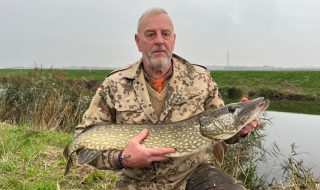Most European anglers won’t be familiar with this fish, known in the USA as the ‘white bass’. And this fish from Devil’s Lake in North Dakota USA, while not massive for bass in general, is a beauty.
In fact at 18.5 inches long, with a 16-inch girth, and weighing in at 4.32lb, it’s being submitted as a new line class world record to the IGFA. Blake LaFleur was fishing in 40ft of water using only 2lb line with a 4lb fluorocarbon leader – the current IGFA world line 2lb line class record stands at 3.5lb.
Blake, who has been specialising in the species for a few years, was fishing through the ice with Kurt Davis, who has helped Blake in honing the approach, which at the business end involved a 16th of an ounce Northland Tackle Buckshot Rattle Spoon. But it was by no means easy – the pair moved 25 times before stumbling across and shoal of fish in a spot he’d never fished before.
“White bass in wintertime feed on larvae in the bottom of the lake, and getting them to bite requires annoying them to bring out their natural aggression,” LaFleur said. “It’s a cat and mouse game. Lures must be kept close, but not so close to the fish that they ignore it, and not so far away they lose interest.”
La Fleur said that the use of fish finders is crucial and that when the screen shows 10 to 12 feet of bass, that’s when action really picks up.
WHITE BASS
White bass are distributed widely across the United States, particularly in the Midwest. They are very abundant in Pennsylvania and the area around Lake Erie. Some native ranges of the white bass are the Arkansas River, Lake Erie near Cleveland, Ohio, and Lake Poinsett in South Dakota; they are abundant in the Winnebago lakes system of Wisconsin; and they are also very abundant in Oklahoma. White bass have also been found in rivers that flow to the Mississippi. Native to many northern habitats, they have been introduced in many different waters around the United States, particularly in southern locations. They were also successfully introduced to Manitoba starting in the 1960s, where they have gained importance as a sport fish.
Source: Wiki






